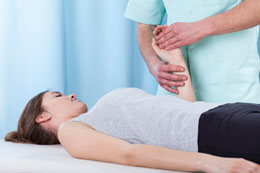Muscle strain, tendonitis, tennis elbow, etc., are some of the contributing factors of pain and weakness in the forearm. This write-up provides information on these conditions.

The forearm is the part of the arm or the upper limb that lies between the elbow and the wrist. It contains two long bones called the ulna and the radius. Trauma, repeated stress to the muscles, or inflammation of the tendon at the elbow could also be responsible for causing pain in this region.
Contributing Factors
Injury
Muscles and ligaments in the forearm could get strained due to an injury. Fractures or dislocation of elbow joint could also cause pain in this part of the arm. Under these circumstances, it becomes very important that you take care not to strain the muscles any further.
Repeated Stress
Golf, tennis, and weightlifting are certain sports that can be responsible for putting excessive stress on the muscles and ligaments of this part of the arm. Tennis elbow is a condition that could cause pain near the elbow. If you experience pain when curling your arm, you must take a break from lifting weights or dumbbells. Exercises that work the front of the elbow region include bicep curls with the barbell or dumbbells, preacher curls, and concentration curls. However, these must be performed using the right technique.
Tendonitis
Tendonitis refers to the inflammation of a tendon. Repeated stress, injury, or degenerative joint disease could cause the tendon in this part of the arm to become inflamed. This condition can give rise to swelling and pain.
Bursitis
The term 'bursa' refers to a small, fluid-filled sac that lies between a bone and muscle, skin, or tendon. If the olecranon bursa that lies at the elbow become inflamed, it could give rise to forearm and elbow pain. This condition could occur due to an injury or joint condition.
Treatment
If you have had an injury recently, it would be advisable to take complete rest. You must not play sports or lift weights till you recover. Wearing a splint on the wrist might also help as that will limit the movement of the wrist and the forearm. An individual who has been experiencing pain, swelling, stiffness, and difficulty in moving the arm must seek medical help to determine if the symptoms are caused due to an underlying medical condition. The use of painkillers, anti-inflammatory drugs, steroids, etc., would help alleviate the symptoms. Application of ice might also help reduce the swelling. It is advisable to go for physiotherapy, so as to strengthen the muscle, and restore the normal range of motion of the arm.
Do take ample rest, and refrain from performing any activity that might put undue stress on the muscles, ligaments, and tendons of the forearm.
Disclaimer:
The information provided in this article is solely for educating the reader. It is not intended to be a substitute for the advice of a medical expert.


 The forearm is the part of the arm or the upper limb that lies between the elbow and the wrist. It contains two long bones called the ulna and the radius. Trauma, repeated stress to the muscles, or inflammation of the tendon at the elbow could also be responsible for causing pain in this region.
The forearm is the part of the arm or the upper limb that lies between the elbow and the wrist. It contains two long bones called the ulna and the radius. Trauma, repeated stress to the muscles, or inflammation of the tendon at the elbow could also be responsible for causing pain in this region.